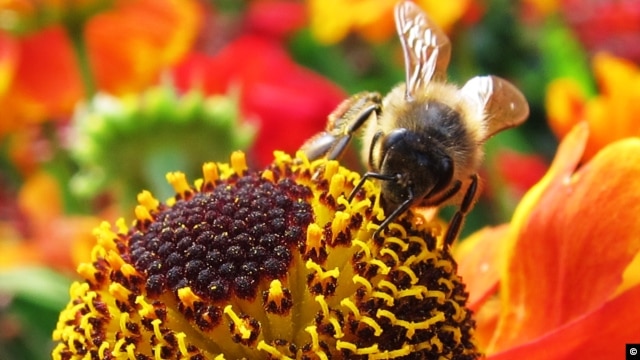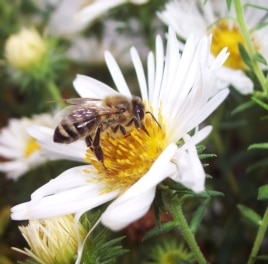Diesel Exhaust Disrupts Bee's Sense of Smell
Honeybees,
a managed species that are trucked to farms, pollinate about 70 percent
of the world’s food crops. (photo credit: Tracey Newman)
October 17, 2013
Air pollution is bad for people. It has been linked to asthma, respiratory problems, cardiovascular diseases and even cancer.
Now comes word that it may also be harmful to bees.
A new study in the journal Scientific Reports finds that exposure to toxic emissions can affect the insect’s ability to recognize the odor of flowers. That is a big problem because bees - as they fly from flower to flower - pollinate about 70 percent of the world’s food crops.
Honeybees in decline
Researchers at Britain’s University of Southampton focused on honeybees, a managed species taken to pollinate farmers’ fields. Each year, about one-third of their hives are wiped out by a mysterious disease called colony collapse disorder.
Dirty air might play a role.
The pollinator relies on its vision and acute sense of smell to do its job, says neurobiologist Tracey Newman, lead author of the study.
"Now, it’s faced with a sea of chemistry every time it goes out on a foraging expedition," said Newman. "So, what it has to do is it has to decipher and discern between those different chemicals to hone in on the plants that it knows are going to give it the best reward in terms of nectar and pollen."
Honeybees use odor to locate, identify and recognize the flowers they forage. Newman's team wanted to know how pollutants would change that process.
Their study asks this question: if you have flowers and flower volatiles - flower perfumes - coming off an environment that is polluted, is the bee compromised in any way in its ability and effectiveness to find the flowers that it’s looking for?
"And in particular," Newman added, "what we wanted to know is not the direct impact on the bee itself, but on the flower chemistry that the bee is having to find."
Foragers take scent back to hive
Bees find those flowers by memorizing scents in the environment. In controlled lab experiments, the insects were taught to associate the smell of rapeseed flowers with nectar. Researchers then added diesel exhaust to the mix to see how well bees could identify the chemically altered fragrance.
"And [we] saw marked changes in the responses of the bees to that new, newly altered scent. The response rate in the bees went down to only a quarter of the original learned response," Newman said.
She found that nitric oxides in diesel exhaust emissions reacted with chemicals from the flower and changed or destroyed them. That process makes troubled hives even more vulnerable, a factor she says has been disregarded in the context of honeybee health, until now.
"However, if you think of a situation, which isn’t hard to imagine, where a bee is dealing with viral infections, mite infections, all the other stresses it has to deal with, another thing that then makes it harder for the bee to work in its environment, so it adds to that list of stresses likely to have detrimental consequences," she said.
Newman and her team have begun field trials to see if they can replicate in the wild what they observed in the lab.
Now comes word that it may also be harmful to bees.
A new study in the journal Scientific Reports finds that exposure to toxic emissions can affect the insect’s ability to recognize the odor of flowers. That is a big problem because bees - as they fly from flower to flower - pollinate about 70 percent of the world’s food crops.
Honeybees in decline
Researchers at Britain’s University of Southampton focused on honeybees, a managed species taken to pollinate farmers’ fields. Each year, about one-third of their hives are wiped out by a mysterious disease called colony collapse disorder.
Dirty air might play a role.
The pollinator relies on its vision and acute sense of smell to do its job, says neurobiologist Tracey Newman, lead author of the study.
"Now, it’s faced with a sea of chemistry every time it goes out on a foraging expedition," said Newman. "So, what it has to do is it has to decipher and discern between those different chemicals to hone in on the plants that it knows are going to give it the best reward in terms of nectar and pollen."
Honeybees use odor to locate, identify and recognize the flowers they forage. Newman's team wanted to know how pollutants would change that process.
Their study asks this question: if you have flowers and flower volatiles - flower perfumes - coming off an environment that is polluted, is the bee compromised in any way in its ability and effectiveness to find the flowers that it’s looking for?
"And in particular," Newman added, "what we wanted to know is not the direct impact on the bee itself, but on the flower chemistry that the bee is having to find."
Foragers take scent back to hive
Bees find those flowers by memorizing scents in the environment. In controlled lab experiments, the insects were taught to associate the smell of rapeseed flowers with nectar. Researchers then added diesel exhaust to the mix to see how well bees could identify the chemically altered fragrance.
"And [we] saw marked changes in the responses of the bees to that new, newly altered scent. The response rate in the bees went down to only a quarter of the original learned response," Newman said.
She found that nitric oxides in diesel exhaust emissions reacted with chemicals from the flower and changed or destroyed them. That process makes troubled hives even more vulnerable, a factor she says has been disregarded in the context of honeybee health, until now.
"However, if you think of a situation, which isn’t hard to imagine, where a bee is dealing with viral infections, mite infections, all the other stresses it has to deal with, another thing that then makes it harder for the bee to work in its environment, so it adds to that list of stresses likely to have detrimental consequences," she said.
Newman and her team have begun field trials to see if they can replicate in the wild what they observed in the lab.



ไม่มีความคิดเห็น:
แสดงความคิดเห็น